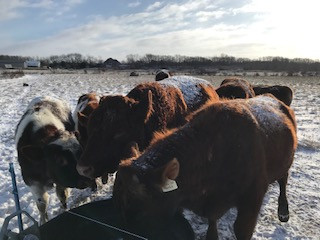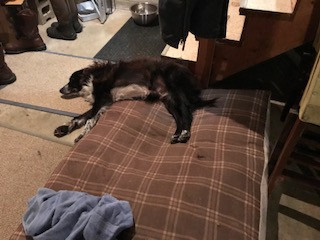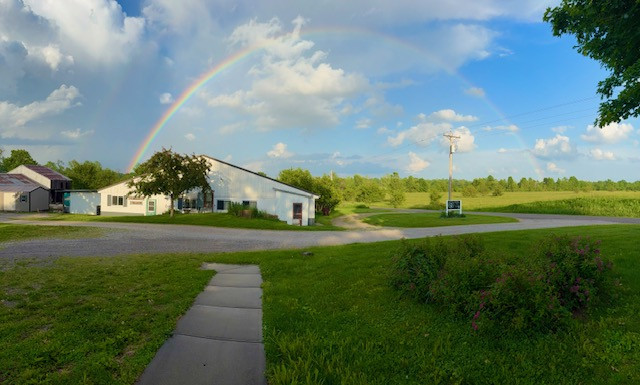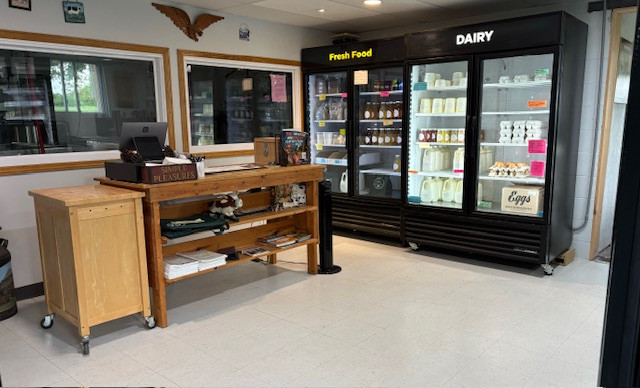Weathering Winter Storms
posted on
December 30, 2022
As human beings who are mostly adapted to living at least part of our lives indoors and being acclimated mainly for prolonged exposure to what we consider "comfortable" ambient temperatures, it can be hard to imagine how animals are able to survive storms outdoors like the one that blasted through just a couple days before Christmas last week.
We worked to prepare for days beforehand, right up until the temps started dropping and winds began picking up Thursday, doing our best to help the livestock weather the abnormally (for here at least) brutal conditions. These are the kinds of storms which make the thought of a nice barn big enough for our over 100 head of cattle at once seem appealing. But unless that barn can contribute to the bottom line the other 350-360 days of the year, it's an expensive investment for creature comfort! And it would probably be a little more for our own peace of mind than the true need for hardy livestock.
The biggest needs for animals outside in the cold of winter are wind protection and full bellies to keep their internal furnace going. You may be surprised to know that a windy, rainy, muddy 35 degree day is likely more uncomfortable for the cows than a calm sunny 5 degree day. Even snow without a lot of wind is not a huge deal for adapted animals (adapted is the key word...don't expect a more pampered barn cow to be as resilient in harsh conditions).
There are a few places on our farm that have areas of trees or brush (and sometimes near buildings), plus a couple hills which help meet this need, but we want to add more trees for this very purpose. Currently we have the herd divided into a small group of bulls, another group of heifer calves and steers born last spring, and the big group of pregnant mamas and next year's beef animals. We assessed the wind direction forecast and put out round bales of hay in each group's location. We set out multiple days' worth of hay for the big group in case we couldn't get the tractor started in the cold.
The chickens had still been out in the pasture for most of December, but we moved their eggmobile and cafeteria in to the barnlot for the winter a couple days earlier, doing whatever we could think of to block some of the wind and hoping for the best.
And then we entered our warm houses and settled in. For hours that night I lay awake, listening to the wind roaring, the welfare of our flock and herd weighing on my mind. I wondered if I had done enough, and if not, what more should I or could I have done?
The next morning, dad bundled up and made the rounds while I prepared lunch for family we had invited. The hillside where we had put the big herd slowed the wind down some, but was still breezy. And though there were icicles around their eyes, he said they seemed to be okay and nobody was shivering or anything. It may be a while before we know if there was any frostbite damage to any teat ends on the udder, which can be a problem in extreme cold and wind.
The calves had gotten on the other side of their polywire, which was to their benefit because the forecast of a slightly northwest wind was pretty much only west or barely southwest so they just got closer to the corner of a hill and woodlot...probably the calmest spot outdoors on the farm.
The bulls had their bellies full and stayed along the brushy fencerow continuing to eat on the extra square bales Doug and I had put out for them there. On Saturday morning I went to water them, and took this picture of snow still on their backs. To me, this picture is a testament to the insulating power of a good thick hide. These guys are allowing so little heat to escape through their hide that their body heat hasn't melted snow on their backs two days later. Side note: the cows all survived, but this water tank did not. After chopping ice for several minutes and then plugging the hose in to the underground hookup, I discovered the water was pouring out of the bottom of the tank as fast as it was running in!

The hens fared ok, although I think the cold addled their brains for a few days! The first cold night just before dark we had to retrieve a few pullets who decided to roost on the eggmobile axle instead of going back inside. On another cold day one pullet was sitting on the ROOF of the eggmobile...in the wind! We did lose one chicken...an old hen which was not looking super perky even before the storm. There is at least one new pullet that started to lay right before the wintry blast and giving us a little egg about every other day, but we're still waiting on the rest! The 54 remaining old hens are still laying a few eggs every day, but during the deep freeze we couldn't even gather eggs often enough to keep most of them from freezing and cracking open. I kicked myself for not thinking of this the first night, but the second night we scattered hay on the screen floor of the eggmobile to hold in their body heat better, and they were much more comfortable the remainder of the cold snap.
There was one animal on the farm who didn't have to endure the storm outside...and from the looks of it, he was pretty happy about that :)






